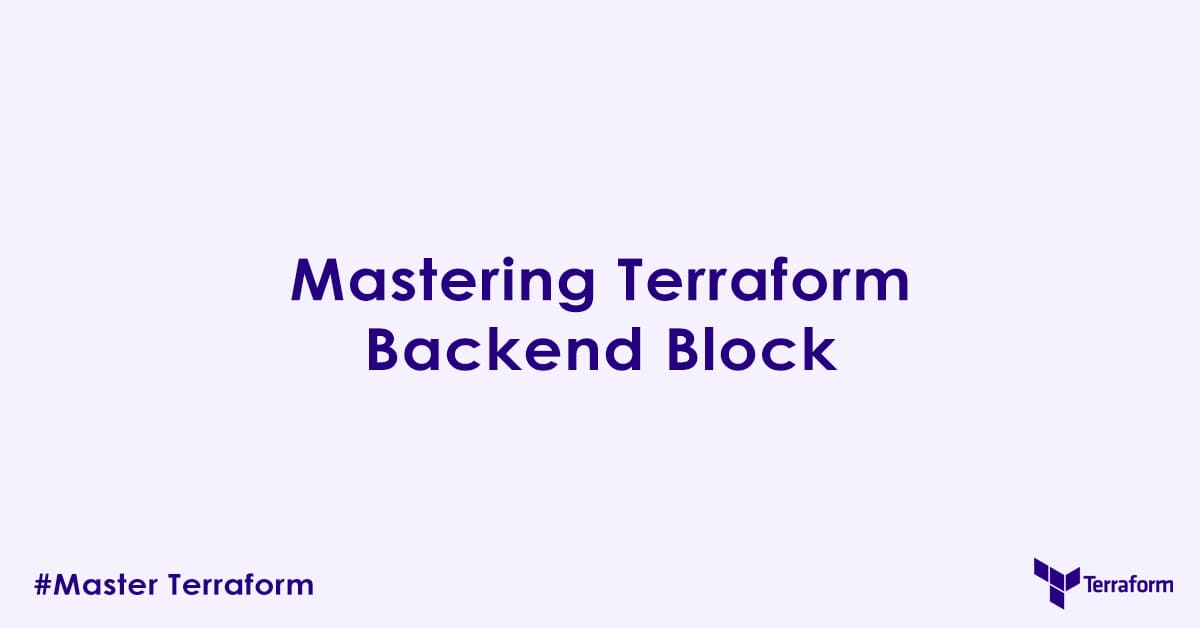In today’s blog post, we will learn terraform backend block, used to configure terraform state file storage and locking configurations. Nested within the terraform block, the backend block is an important configuration for how Terraform manages its state file (terraform.tfstate).
This detailed guide will walk you through the terraform backend block, covering its fundamental purpose, popular types, essential configuration arguments, and the best practices that will help you to securely setup terraform backends for a collaborative environment.
What is the backend Block and Why Do You Need It?
The backend block configures Terraform’s state storage and locking mechanism. By default, Terraform uses a local backend, meaning the terraform.tfstate file is stored directly on the machine where you run Terraform commands. While simple, this approach quickly becomes problematic for teams and production environments.
The backend block allows you to specify a remote backend, which stores your state file in a shared, persistent, and often versioned storage system.
Key Reasons to Use a Remote Backend (configured via the backend block):
- Collaboration: It enables multiple team members or CI/CD pipelines to work on the same infrastructure concurrently without overwriting each other’s changes.
- State Locking: Most remote backends provide mechanisms to prevent race conditions during
terraform applyoperations by acquiring and releasing a lock on the state file. This is important for preventing state corruption. - Durability & Reliability: Your state file is stored in a highly available and redundant service, protecting it from local machine failures or accidental deletion.
- Security: Remote backends often support encryption of the state file at rest and allow granular access control policies.
- Auditing & Versioning: Many backend services automatically version state changes, providing a historical record and enabling rollbacks if needed.
Syntax of the backend Block
The backend block is nested within the terraform block, and you can only define one backend block per root module.
terraform {
# ... other terraform settings like required_version, required_providers ...
backend "<backend_type>" {
# Backend-specific arguments
# E.g., for S3: bucket, key, region, encrypt, dynamodb_table
# E.g., for azurerm: resource_group_name, storage_account_name, container_name, key
}
}<backend_type>: Specifies the type of remote backend you want to use (e.g.,s3,azurerm,gcs,consul,remote).- Backend-specific arguments: Each backend type has its own set of mandatory and optional arguments for configuration.
Popular Backend Types and Examples
Let us look at the most commonly used remote backends.
AWS S3 Backend (with DynamoDB Locking)
The AWS S3 backend is extremely popular due to its high durability, scalability, and integration with AWS services for locking and encryption. It typically uses an Amazon DynamoDB table for state locking.
Prerequisites:
- An S3 bucket for storing the state file (e.g.,
my-terraform-state-bucket-unique). - A DynamoDB table for state locking (e.g.,
my-terraform-state-lock-table), with a primary key namedLockID(String type).
Configuration:
# main.tf or versions.tf
terraform {
required_providers {
aws = {
source = "hashicorp/aws"
version = "~> 5.0"
}
}
backend "s3" {
bucket = "my-terraform-state-bucket-unique" # Must be globally unique
key = "environments/prod/my-app.tfstate" # Path to the state file within the bucket
region = "us-east-1"
encrypt = true # Enables server-side encryption for the state file
dynamodb_table = "my-terraform-state-lock-table" # Name of the DynamoDB table for state locking
acl = "private" # Restricts public access to the state file
}
}
provider "aws" {
region = "us-east-1"
}Explanation:
bucket: The name of your S3 bucket.key: The object key within the S3 bucket where your state file will be stored. This allows you to store multiple state files in one bucket.region: The AWS region where your S3 bucket and DynamoDB table reside.encrypt: Set totrueto enable AES-256 server-side encryption of the state file in S3.dynamodb_table: The name of the DynamoDB table used for state locking. This is important for preventing concurrentterraform applyoperations from corrupting your state.acl: Access Control List for the S3 object,privateis generally recommended.
Azure Blob Storage Backend
For users deploying on Azure, the Azure Blob Storage backend is the native and highly recommended solution. It uses Azure Storage Blobs for state storage and Blob Lease for locking.
Prerequisites:
- An Azure Storage Account (e.g.,
tfstateaccount). - A Blob Container within that storage account (e.g.,
tfstate).
Configuration:
# main.tf or versions.tf
terraform {
required_providers {
azurerm = {
source = "hashicorp/azurerm"
version = "~> 3.0"
}
}
backend "azurerm" {
resource_group_name = "tfstate_rg" # Resource group where storage account exists
storage_account_name = "tfstateaccount" # Your Azure Storage Account name
container_name = "tfstate" # Blob container name
key = "prod/my-app.tfstate" # Path to the state file within the container
snapshot = true # Enable snapshotting for state backups
}
}
provider "azurerm" {
features {}
}Explanation:
resource_group_name,storage_account_name,container_name,key: Define the specific location of your state file within Azure Blob Storage.snapshot: Whentrue, Terraform will take a snapshot of the state file before modifying it, providing versioning.
Google Cloud Storage (GCS) Backend
For Google Cloud users, GCS offers a highly available and durable backend for Terraform state. GCS buckets inherently support object versioning for state history and object locking (using GCS’s native object locking or custom mechanisms for stronger concurrency control).
Prerequisites:
- A GCS Bucket for storing the state file (e.g.,
my-gcp-terraform-state-bucket).
Configuration:
# main.tf or versions.tf
terraform {
required_providers {
google = {
source = "hashicorp/google"
version = "~> 5.0"
}
}
backend "gcs" {
bucket = "my-gcp-terraform-state-bucket" # Your GCS bucket name
prefix = "prod/my-app/" # Optional: Prefix for objects in the bucket
# The actual state file will be at 'prod/my-app/default.tfstate' (or workspace name)
}
}
provider "google" {
project = "my-gcp-project-id"
region = "us-central1"
}Explanation:
bucket: The name of your GCS bucket.prefix: An optional prefix for the state file within the bucket. Terraform will append/default.tfstate(or/myworkspace.tfstatefor workspaces) to this prefix.
HashiCorp Cloud Platform (HCP) Terraform (Managed Service)
HCP Terraform (formerly Terraform Cloud) offers a fully managed solution for remote state, remote operations, state locking, and collaboration. If you are invested in the HashiCorp ecosystem, this is often the simplest and most integrated solution. It is configured using the cloud block, which also resides within the terraform block.
# main.tf or versions.tf
terraform {
# ... (other terraform settings) ...
cloud {
organization = "my-hcp-organization" # Your HCP Terraform organization name
# Optional: Associate this configuration with a specific workspace in HCP Terraform
# If omitted, Terraform will prompt or infer based on current directory.
workspace {
name = "my-prod-workspace"
}
}
}Explanation: When you run terraform init with this configuration, Terraform connects to HCP Terraform, and all plan/apply operations are managed remotely, with state stored securely in HCP Terraform.
Initializing and Migrating State
After configuring your backend block:
First-time initialization (no existing state):
terraform initMigrating from local state to remote: (local state file exists)
terraform init -migrate-stateTerraform will detect the new backend, prompt you to migrate your existing local state file to the remote backend, and then save the configuration. Confirm the migration.
Changing remote backend configuration: If you modify arguments within an existing backend block (e.g., change the key in S3), you also need to run terraform init -migrate-state to safely move the state if necessary.
Key Considerations and Best Practices
backendCannot Use Variables (Directly): A common frustration: you cannot use Terraform variables directly within thebackendblock’s arguments. This is because the backend needs to be configured before variables are evaluated.- Solution: Use partial backend configuration or environment variables.
- Partial configuration: Omit sensitive/dynamic values from the HCL, and provide them via
terraform init -backend-config="key=value"flags or.tfbackendfiles. - Environment variables: For some backends (like S3), you can use environment variables (e.g.,
AWS_ACCESS_KEY_ID,AWS_SECRET_ACCESS_KEY,AWS_REGION). - Recommended: Use environment variables for credentials and direct configuration for static backend details like bucket/key.
- Partial configuration: Omit sensitive/dynamic values from the HCL, and provide them via
- Solution: Use partial backend configuration or environment variables.
- State Locking: Always ensure your chosen backend is configured for state locking (e.g., DynamoDB for S3, Blob Lease for Azure). This prevents concurrent operations from corrupting your state file.
- Authentication: Ensure the identity running Terraform (your user, CI/CD service principal/role) has the necessary permissions to read, write, and lock state in your chosen backend.
- Security of the Backend Itself:
- Encryption: Always enable encryption for your state files at rest in the backend (e.g., S3
encrypt = true). - Access Control: Apply strict access control policies to your backend storage to limit who can access the state file.
- Sensitive Data: Remember that sensitive data (even if marked
sensitive=truein HCL) can still end up in the state. Use secret management tools and ephemeral resources where appropriate.
- Encryption: Always enable encryption for your state files at rest in the backend (e.g., S3
- One Backend Per Root Module: A
backendblock must only exist in your root Terraform configuration. Child modules should not define their own backends. - Modular State Isolation: For large projects, consider having separate root Terraform configurations (and thus separate state files) for logically distinct parts of your infrastructure (e.g.,
network,compute,database). Use data source"terraform_remote_state"to read outputs from one state file into another. This limits the blast radius of errors and speeds up operations. - Version Control: Your HCL code (which includes the
backendblock) should always be in version control (e.g., Git). Theterraform.tfstatefile itself should never be committed to Git when using remote state.
Conclusion
Setting up a proper backend in Terraform is one of the most important steps for managing your infrastructure safely and efficiently. Whether you are working alone or in a team, using a remote backend helps protect your data, allows teamwork without conflicts, and keeps your setup more organized. Always choose the right backend for your cloud provider, follow best practices like enabling encryption and using state locking, and never store your state files in version control. A good backend setup gives you peace of mind and makes your Terraform projects much smoother.
Author

Experienced Cloud & DevOps Engineer with hands-on experience in AWS, GCP, Terraform, Ansible, ELK, Docker, Git, GitLab, Python, PowerShell, Shell, and theoretical knowledge on Azure, Kubernetes & Jenkins.
In my free time, I write blogs on ckdbtech.com
